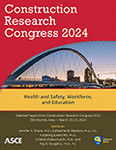Training Development of Infectious Diseases for Construction Workers
Publication: Construction Research Congress 2024
ABSTRACT
Construction workers may be at an elevated risk of contracting infectious diseases due to unsanitary conditions and constant exposure to health hazards on jobsites. Poor sanitation is one of the major causes of the spreading of infectious diseases. Construction workers with poor or limited sanitary conditions may struggle with safe drinking water, hand washing, access to clean toilets, and properly handled and serviced food. Some examples of infectious diseases include the common cold, flu, tuberculosis, pneumonia, and human immunodeficiency virus/acquired immunodeficiency syndrome (HIV/AIDS). This paper develops several training scenarios on infectious diseases to keep construction workers safe and healthy in the construction industry. The authors collected documents and scenarios on four topics: potential exposures to infectious diseases, common causes and types of infectious diseases, precaution and prevention strategies, and control and protection plans. The authors analyzed scenarios collected from real-world construction projects and synthesized them in training manuals. The developed manuals are publicly available for corporate trainers and university educators to train construction workers and students. The research outcomes provide preliminary guidance and effective practices for training workers and preventing infectious diseases on construction jobsites.
Get full access to this article
View all available purchase options and get full access to this chapter.
REFERENCES
CDC (Centers for Disease Control and Prevention). (2020). “Illness and symptoms.” <https://www.cdc.gov/cholera/illness.html>(March 21, 2023).
CDC (Centers for Disease Control and Prevention). (2021). “Illness and symptoms.” <https://www.cdc.gov/legionella/index.html>(March 21, 2023).
De Perio, M. A., et al. (2021). “Occupational histoplasmosis: Epidemiology and prevention measures.” Journal of Fungi, MDPI AG.
Farnham, A., Alleyne, L., Cimini, D., and Balter, S. (2014). “Legionnaires’ disease incidence and risk factors, New York, New York, USA, 2002-2011.” Emerging Infectious Diseases, Centers for Disease Control and Prevention (CDC), 20(11), 1795–1802.
Jayakrishnan, T., Thomas, B., Rao, B., and George, B. (2013). “Occupational health problems of construction workers in India.” International Journal of Medicine and Public Health, EManuscript Services,3(4), 225.
Khatun, H., Islam, S.B., Naila, N. N., Islam, S. A., Nahar, B., Alam, N. H., and Ahmed, T. (2018). “Clinical profile, antibiotic susceptibility pattern of bacterial isolates and factors associated with complications in culture-proven typhoid patients admitted to an urban hospital in Bangladesh.” Tropical Medicine and International Health, Blackwell Publishing Ltd, 23(4), 359–366.
Lacasse, Y., and Cormier, Y. (2006). “Hypersensitivity pneumonitis.” In Orphanet Journal of Rare Diseases (Vol. 1, Issue1). https://doi.org/10.1186/1750-1172-1-25.
Lopez-Leon, S., Wegman-Ostrosky, T., Perelman, C., Sepulveda, R., Rebolledo, P. A., Cuapio, A., and Villapol, S. (2021). “More than 50 Long-term effects of COVID-19: a systematic review and meta-analysis.” Scientific Reports, Nature Portfolio.
Merriam-Webster. (2022). “Infectious disease definition & meaning.” Merriam-Webster. Retrieved November 10, 2022, from https://www.merriam-webster.com/dictionary/infectious%20disease.
Patel, A. M., Ryu, J. H., and Reed, C. E. (2001). “Hypersensitivity pneumonitis: Current concepts and future questions.” Journal of Allergy and Clinical Immunology, Mosby Inc., 108(5), 661–670.
Serne, J., and Dang, H. (2023). “Effective Safety Protocols and Project Productivity Impacts for Construction Companies in Washington State During the COVID-19 Pandemic.” Proceedings of the Canadian Society of Civil Engineering Annual Conference 2021. CSCE 2021. Lecture Notes in Civil Engineering, vol 247. Springer, Singapore. https://doi.org/10.1007/978-981-19-0968-9_16.
Su, C. P., de Perio, M. A., Cummings, K. J., McCague, A. B., Luckhaupt, S. E., and Sweeney, M. H. (2019). “Case investigations of infectious diseases occurring in workplaces, United States, 2006-2015.” Emerging Infectious Diseases, Centers for Disease Control and Prevention (CDC),25(3), 397–405.
US DHHS (US Department of Health and Human Services). (2022). “Diseases & Conditions. National Institute of Allergy and Infectious Diseases.” Retrieved November 10, 2022, from https://www.niaid.nih.gov/diseases-conditions?f%5B0%5D=disease%3A53.
Velavan, T. P., and Meyer, C. G. (2020). “The COVID-19 epidemic.” Tropical Medicine and International Health, Blackwell Publishing Ltd.
Information & Authors
Information
Published In
History
Published online: Mar 18, 2024
ASCE Technical Topics:
Authors
Metrics & Citations
Metrics
Citations
Download citation
If you have the appropriate software installed, you can download article citation data to the citation manager of your choice. Simply select your manager software from the list below and click Download.
